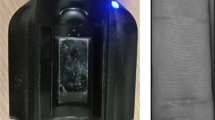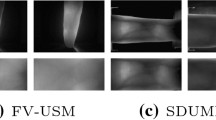Abstract
Leakage of unprotected biometric authentication data has become a high-risk threat for many applications. Lots of researchers are investigating and designing novel authentication schemes to prevent such attacks. However, the biggest challenge is how to protect biometric data while keeping the practical performance of identity verification systems. For the sake of tackling this problem, this paper presents a novel finger vein recognition algorithm by using secure biometric template scheme based on deep learning and random projections, named FVR-DLRP. FVR-DLRP preserves the core biometric information even with the user’s password cracked, whereas the original biometric information is still safe. The results of experiment show that the algorithm FVR-DLRP can maintain the accuracy of biometric identification while enhancing the uncertainty of the transformation, which provides better protection for biometric authentication.










Similar content being viewed by others
References
Ang R, Safavi-Naini R, Mcaven L (2005) Cancelable key-based fingerprint templates. In: Proceedings of the Australasian conference information security and privacy (ACISP 2005), Brisbane, Australia, July 4–6, 2005, pp 242–252
Chen C, Wu Z, Li P, Zhang J, Wang Y, Li H (2015) A finger vein recognition algorithm using feature block fusion and depth neural network. In: International symposium on intelligence computation and applications, Springer, Berlin, pp 572–583
Gu B, Sheng VS, Tay KY, Romano W, Li S (2014) Incremental support vector learning for ordinal regression. IEEE Trans Neural Netw Learn Syst 26(7):1403–1416
Hinton GE (2010) A practical guide to training restricted Boltzmann machines. Momentum 9(1):599–619
Hinton GE, Osindero S, Teh YW (2006) A fast learning algorithm for deep belief nets. Neural Comput 18(7):1527–1554
Jain AK, Ross A, Uludag U (2005) Biometric template security: Challenges and solutions. In: 2005 13th European signal processing conference. IEEE, pp 1–4
Kong A, Zhang D, Kamel M (2008) Three measures for secure palmprint identification. Pattern Recogn 41(4):1329–1337
Li X, Guo S, Gao F, Li Y (2007) Vein pattern recognitions by moment invariants. In: The international conference on bioinformatics and biomedical engineering, pp 612–615
Li J, Chen X, Li M, Li J, Lee PPC, Lou W (2013) Secure deduplication with efficient and reliable convergent key management. IEEE Trans Parallel Distrib Syst 25(6):1615–1625
Li J, Li X, Yang B, Sun X (2015a) Segmentation-based image copy-move forgery detection scheme. IEEE Trans Inf Forensics Secur 10(3):507–518
Li J, Li YK, Chen X, Lee P, Lou W (2015b) A hybrid cloud approach for secure authorized deduplication. IEEE Trans Parallel Distrib Syst 26(5):1206–1216
Lim MH, Teoh ABJ, Toh KA (2012) An efficient dynamic reliability-dependent bit allocation for biometric discretization. Pattern Recognit 45(5):1960–1971
Liu Z, Yin Y, Wang H, Song S, Li Q (2010) Finger vein recognition with manifold learning. J Netw Comput Appl 33(3):275–282
Maio D, Nanni L (2005) Multihashing, human authentication featuring biometrics data and tokenized random number: a case study fvc2004. Neurocomputing 69(1):242–249
Maiorana E (2010) Biometric cryptosystem using function based on-line signature recognition. Expert Syst Appl 37(4):3454–3461
Nanni L, Lumini A (2008) Random subspace for an improved biohashing for face authentication. Pattern Recognit Lett 29(3):295–300
Pankanti S, Jain A, Hong L (2000) Biometrics: promising frontiers for emerging identification market. Comm ACM 43:91–98
Quan F, Fei S, Anni C, Feifei Z (2008) Cracking cancelable fingerprint template of ratha. In: International symposium on computer science and computational technology, pp 572–575
Ratha NK, Connell JH, Bolle RM (2001) Enhancing security and privacy in biometrics-based authentication systems. IBM Syst J 40(3):614–634
Ratha NK, Chikkerur S, Connell JH, Bolle RM (2007) Generating cancelable fingerprint templates. IEEE Trans Pattern Anal Mach Intell 29(4):561–572
Rua EA, Maiorana E, Castro JLA, Campisi P (2012) Biometric template protection using universal background models: an application to online signature. IEEE Trans Inf Forensics Secur 7(1):269–282
Shen J, Tan H, Wang J, Wang J, Lee S (2015) A novel routing protocol providing good transmission reliability in underwater sensor networks. J Internet Technol 16(1):171–178
Uludag U, Pankanti S, Prabhakar S, Jain AK (2004) Biometric cryptosystems: issues and challenges. Proc IEEE 92(6):948–960
Wang KJ (2007) Finger vein recognition based on wavelet moment fused with PCA transform. Pattern Recognit Artif Intell 20(5):692–697
Wang J, Ma H, Tang Q, Li J, Zhu H, Ma S, Chen X (2013) Efficient verifiable fuzzy keyword search over encrypted data in cloud computing. Comput Sci Inf Syst 10(2):667–684
Wen X, Shao L, Xue Y, Fang W (2015) A rapid learning algorithm for vehicle classification. Inf Sci 295:395–406
Wu Z, Liang B, You L, Jian Z, Li J (2016a) High-dimension space projection-based biometric encryption for fingerprint with fuzzy minutia. Soft Comput 20(12):4907–4918
Wu Z, Yu Z, Yuan J, Zhang J (2016b) A twice face recognition algorithm. Soft Comput 20(3):1007–1019
Wu Z, Yuan J, Zhang J, Huang H (2016c) A hierarchical face recognition algorithm based on humanoid nonlinear least-squares computation. J Ambient Intell Human Comput 7(2):229–238
Yan F, Tan Y, Zhang Q, Wu F, Cheng Z, Zheng J (2016) An effective raid data layout for object-based de-duplication backup system. Chin J Electron 25(5):832–840
Zheng Y, Byeungwoo J, Xu D, Wu QMJ, Zhang H (2015) Image segmentation by generalized hierarchical fuzzy c-means algorithm. J Intell Fuzzy Syst 28(2):4024–4028
Zhu R, Ya Tan, Zhang Q, Fei W, Zheng J, Yuan X (2016a) Determining image base of firmware files for arm devices. IEICE Trans Inf Syst 99(2):351–359
Zhu R, Ya Tan, Zhang Q, Li Y, Zheng J (2016b) Determining image base of firmware for arm devices by matching literal pools. Dig Investig 16:19–28
Acknowledgements
This work is supported by the National Natural Science Foundation of China (61572144), the Natural Science Foundation of Guangdong (2014A030313517), the Science and Technology Planning Project of Guangdong Province (2015B010129015, 2013B040500009), the Zhejiang Sicence Fund No. LY16F020016 and the Innovation Team Project of Guangdong Universities (No 2015KCXTD014).
Author information
Authors and Affiliations
Corresponding author
Ethics declarations
Conflict of interest
Yi Liu, Jie Lin, Zhusong Liu, Jian Shen and Chongzhi Gao all declare that they have no conflict of interest.
Additional information
Communicated by V. Loia.
Rights and permissions
About this article
Cite this article
Liu, Y., Ling, J., Liu, Z. et al. Finger vein secure biometric template generation based on deep learning. Soft Comput 22, 2257–2265 (2018). https://doi.org/10.1007/s00500-017-2487-9
Published:
Issue Date:
DOI: https://doi.org/10.1007/s00500-017-2487-9




